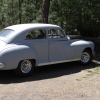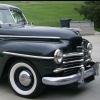Leaderboard
Popular Content
Showing content with the highest reputation on 06/20/2014 in all areas
-
Just heard through the 39-47 group Don Bunn passed away last night. The hobby has lost a great supporter.2 points
-
Oh by the way I have deduced that ohms is the practical measurment of the effectivness of "jiggle the wires". I had the sender out, couldn't get any thing but zeros on my meter, put it back in, cleaned up the contacts, put the blue on #1 and the yellow on #2, cleaned the ground wire and screw, and now magically i have just a bit less than half a tank. Since I put 6.5 gallons in yesterday and drove about 12 miles home, I should have closer to 1/3 tank, as the tank is supposed to hold 17 gallons. So it will still be close to empty at 1/4 tank reading but at least it is now reacting. So OHMS = the given quantity of jiggles (wires you perverts) over a time of less than ten minutes. That is my theory and I'm sticking to it.2 points
-
Family legend: My dad had a 47 DeSoto Suburban to haul around us seven kids. We lived some distance from our relatives, so when we went to visit, my dad traveled at night. Three reasons: 1) He avoided the flashing of the sun and shadows of the trees beside the road, which gave him headaches; 2) Traffic was light, in the country, with no farm implements on the roads, and in the cities, where there were few cars on the streets and the traffic signals would be only flashing; and 3) The kids were bunked down in the back, and quiet if not sleeping. The problem was that there were few gas stations open, and my dad seemed to ignore the gas gauge. Once, he ran out of gas in the middle of the night. He was lucky to find a gas station a few blocks away where they had forgotten to turn off the pumps. He put some gas in an enameled steel potty which we carried in the car for other purposes, and brought enough gas back to get the car started and to the station. My dad filled up the car, and slipped the $1.75 under the door of the station. (Might have been more than that. 17 gallons at maybe 20 cents, OK, he slipped the $3.40 under the door.)2 points
-
on a later model those values may be present...but for the early two wire the setup is a bit different..first the voltage is applied to the gauge..the gauge has a built in voltage regulator..the gauge is also a push pull circuit...the needle is being stabilized by proportional difference of the single value resistor in the tank as it goes to common ground through each leg....that is the why for two wires...theoretically the 30 ohm resistor (nominal value as most are 28-32 ohms) is wired to each side of the guage as the wiper moves from full to empty the ohms are split proportionally to ground....if 20 on one leg the then 10 remainly ohms ins on the other..this proves for a very slow moving and accurate gauge that is not affected by fuel slosh..it is also important to ensure that the wires are properly attached to gauge and sender...some are maked each end as A & B and some are referenced as 1 & 2 connect like terminals..both wires must be making good clean connections to properly read..the wiper inside the sender must be clean and making good contact throughout its arc.. also...any low or loose spot between the wrapped wires of the resistor and the wiper pickup will cause an open in the circuit..majority of the sender I have seen have a bad wiper contact to the housing and not bad contact to the wrapped wire wiper/pickup..it is a tension pivot within a cup inside the housing..these usually is the failure point as the metal within the cup can and will corrode...it is not hard to disassemble and clean the sender..if your resistor is good (30 ohms across both terminals) and the wiper reading are smooth to the arm..and not smooth to the cup when amking comparison reading to the sender housing..then you probably have this corrosion..one can use a jumper here similar to the very nice braided thin wire used in the distributor to make an effective ground. Do ensure you have a good sender to chassis ground as age and corrosion at the tank flange itself can be questionable..1 point
-
First thing to do, ground the body of the sending unit with a dedicated wire, I attached mine from one of the screws holding the sender to the tank to one of the screws on the cover plate. Also look up under the dash and make sure there is nothing in accidental contact with the fuel gauge terminals. I had my defroster duct work itself loose and the wire reinforcing the tube was in contact with one of the terminals grounding it thus putting it in a non operative condition. I have been doing the math thing at gas replenishments but I musta got my carries wrong on the last one as I was at least 15 miles short.....fortunately we were close to a gas station. I usually carry an empty gas can in the car but of course not last night. So I bought a gallon of water, drank some, dumped the rest, and used it to take gas tot he car.1 point
-
I'm a fan of the flathead six. Sure would be easy to rebuild it, shave the head a bit and put a couple of carbs on it. Or lightly turbo charge it. I think the wow factor with a flathead is above and beyond that of any modern engine transplant. Nothing out-cools a flathead. And going the way of the transplant is at best always a hard, long, and expensive journey. Sorry, just had to say it! Sorry sorry sorry. Having said that, I believe the slant six makes the most sense. Someone (I forget who) on this forum has done it, and knows the way. k.1 point
-
Me stupid too when it comes to ohms and such...I'll be watching this thread as Lumpy never has had a working gas gauge in the fifteen or twenty years I've been driving her. I think my sending unit works, but I'm not sure. I write down my mileage when I get gas, and keep a full two gallon gas container in the trunk, and never have run out of gas. But I'd rather have a gauge. (that worked) Wish the odometer had a trip meter, then it would be just like riding an old motorcycle. Once you figure out how many miles you get out of a tank of gas, you just get gas when you are about 50, 40, 30 miles shy of that mileage. k.1 point
-
You know, I never did see any cars with a Knuckle Scraper decal, or anything like that. As it was pretty warm outside, didn't see any Knuckle Scraper jackets either....so I'm not sure who exactly the Knuckle Scrapers are. There was a T-shirt booth, but I never did get around to talking to those people. They could have been/probably were the Knuckle Scrapers. So far, knock on wood, in the 15-20 years I've been driving Lumpy, she's never failed to return home on her own power. I bought her in Colfax, probably about something short of 100 miles away, and drove her home, so she's never been on a trailer or truck as long as I've had her. One time my fuel pump went out, but I was able to pull over a couple of times, let it cool off (electric pump), and start up and drive again, and we got home. So Lumpy is a very good girl, and I figure as reliable as any other car...but yes, stuff happens! You never know. k.1 point
-
The Sisson choke is half-and-half. The electronic closing is during cranking only. Once the engine starts, it shouldn't need so much choking. The bimetallic closing is related to the temperature of the manifold, and eases off as the engine warms up. Before starting, the accelerator pedal should be pushed enough to set the fast idle. Pumping the pedal squirts extra gas, which may or not be needed, depending somewhat on the vagaries of the engine. Trial and error.1 point
-
On the way home. Put on 184 miles that day, and drove through the most beautiful country you can imagine, rolling hills of grass and wheat, back highways with little or no traffic. We drove back via Colfax, then Endicot, St.John, Ewan, then up the Rock Lake road to Cheney, if you are familiar with Eastern Washington. Drove down there via Spangle, Rosalia, Oaksdale. This pic is where we stopped on the Endicot/St.John road to have a little rest-stop and eat. The Knuckle Scraper meet/show is really cool. They don't allow cars that are trailered in. It's in a way out of the way place, so you have to drive 50-60-100 miles at least to get there. So you see mostly drivers, lots of rat-rods, and some show cars that someone at least wasn't afraid to drive a few miles. All the roads, highways and byways to get there are in perfect condition, no traffic to speak of, you just couldn't ask for a better drive. And yes, Lumpy ran so fine...just absolutely perfect. Thanks for listening! Ken.1 point
-
I now use my engine hoist for radiators on some of my cars- the radiators are just too big and heavy like the 1940-48 chrysler eight cylinder radiators-they are big and heavy!1 point
-
I installed a Champion radiator in my P15 a few years ago. Seems to be very well made and reasonably priced but at the time, they did not offer a radiator to fit the P15. The radiator I ended up with was meant for a mid 60's Ford Mustang. It was the best fit of their offerings. It works OK, but I'm interested in this thread, as the V8 in the car could use some reserve cooling on long grades, At times it tends to run hotter than I'm comfortable with, although it's never really overheated. This new radiator has a larger core than the one I used. If Don is satisfied with his new radiator, I might look into upgrading mine. I'll be following this thread. Wayne1 point
-
Just out of curiosity have you asked this question on a chevy forum? I don't think there are a lot of folks on this forum who know much about your engine.1 point
-
My son was going to drop the grandkids off at 4:30. I was going to have him help me lift it out. At 4:45 he had not arrived yet so I did it myself. He arrived at 4:47, honked and waved as he dropped the grandkids off and went speeding off into the sunset.1 point
-
Nice, I am running the same radiator in my Wayfarer for a few months now... No problems so far...1 point
-
Quite possibly the green is caused by corroding brass and/or copper parts in the fuel system, fuel is probably really cloudy too due to moisture as well.1 point
-
1 point
-
There is a wire in the distributor that often causes this problem . This is a finely braded wire that must move every time you use the throttle . If it is broken on the inside or grounding out where it shouldn't , then you will have this problem . I think that Plymouthy referred to this wire .1 point












